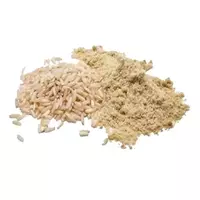Rice bran

Nowadays, many have begun to adhere to a system of healthy and balanced nutrition, which includes new previously not at all in demand products, which include bran. In essence, bran is a waste of production or, so-called, recyclable materials that are obtained in the process of processing grains of cereal crops. Depending on the initial raw materials, bran is divided into several species, which differ in their appearance, beneficial and nutritious properties.
Currently, the following main types of bran can be found on sale: wheat, rye, oat, barley and rice bran. It is worth noting that many types of bran use not only as a food, but also pet food. It is noteworthy that of all types of bran, rice is not very popular among domestic consumers.
This is probably due to the ignorance of buyers about the unique beneficial and nutritious properties of rice bran. A very different situation has developed in Asian countries, where rice has been considered the main food for centuries. Often, experts in the Asian culinary tradition call rice "Asian" bread. Therefore, it is not surprising that residents of Asian countries know and actively use the benefits of rice bran for their own benefit.
Benefits of rice bran
Rice bran are fragments of rice grain shells that stand out with a pronounced aroma. Often, in the composition of rice bran, not only the shell comes across, but also parts of the grains, as well as the pericarp of the plant. The properties of rice bran are similar to other types of product. The benefits of rice bran lie in the composition of the product, which is enriched with a significant amount of useful compounds. For example, the chemical composition of rice bran contains vitamins of group B, E, K, as well as PP.
In addition, rice bran is enriched with iron, sodium, selenium, zinc, magnesium, choline and other substances important for human life. It is noteworthy that the composition of rice bran is dominated by carbohydrates, which saturate the body with energy, which is necessary for the normal life of a person.
Regular consumption of rice bran helps to cleanse the human body of harmful compounds that penetrate from the environment, as well as arise in the process of vital activity. Doctors and nutritionists recommend regularly eating rice and other types of bran to everyone without exception.
Rice bran will be of particular benefit to people who suffer from various types of diseases of the gastrointestinal tract, pancreas, as well as the liver and kidneys. Rice bran also helps in the prevention and treatment of atherosclerosis, diabetes and allergies. Rice bran occupies a special place in the medical diet, the product helps to support the body and saturate it with important biologically active compounds, as well as vitamins.
316 kCal rice bran
Energy value of rice bran (Ratio of proteins, fats, carbohydrates - ju):
Proteins: 13.35 (~ 53 kCal)
Fats: 20.85 g (~ 188 kCal)
Carbohydrates: 28.9 g (~ 116 kCal)
Energy ratio (b | y): 17% | 59% | 37%
 Español
Español Français
Français Português
Português Русский
Русский 简体中文
简体中文 繁體中文
繁體中文 日本語
日本語 한국어
한국어 العربية
العربية Türkçe
Türkçe Қазақ
Қазақ Deutsch
Deutsch Italiano
Italiano Українська
Українська
